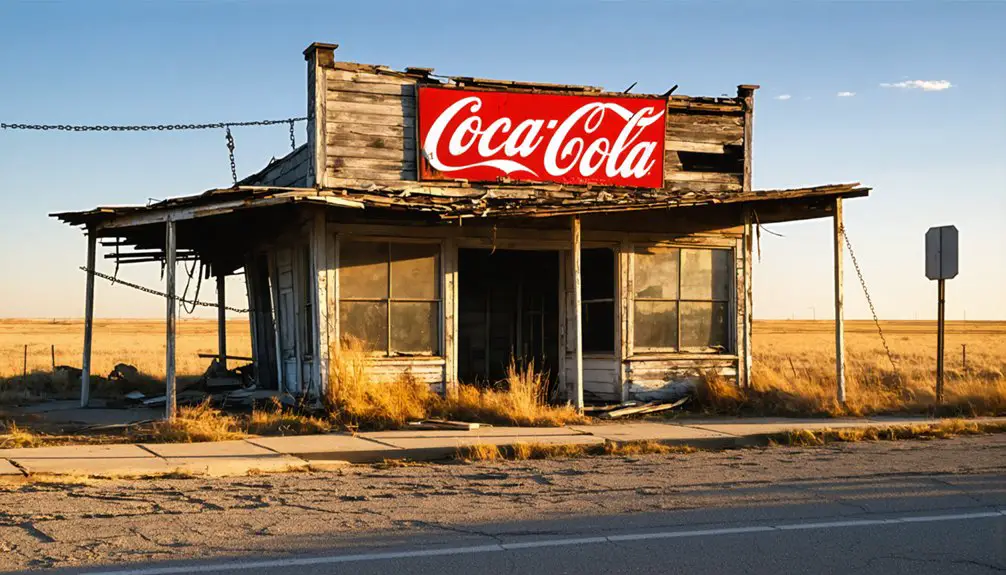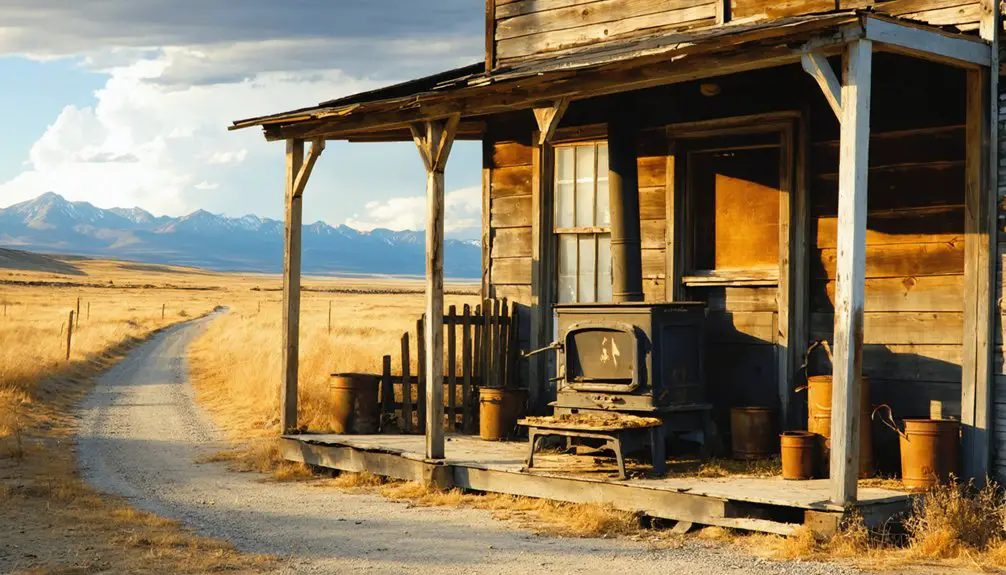You’ll find Exeter, Montana’s mining history rooted in its 1860s discovery of rich mineral deposits, including copper, gold, silver, and zinc. The town flourished after the 1880 railroad arrival, supporting four large smelters and a community of several hundred residents with saloons, schools, and stores. While the 1893 Sherman Silver Purchase Act repeal triggered decline, you can still explore deteriorating storefronts, mining artifacts, and railway remnants that tell a deeper story of boom-and-bust frontier life.
Key Takeaways
- Exeter emerged as a significant mining hub in 1860s Montana, producing copper, gold, silver, lead, zinc, manganese, and molybdenum.
- The town supported several hundred residents with amenities including saloons, dance halls, stores, schools, and churches during peak mining years.
- Four large smelters established by 1884 marked industrial-scale mining operations, transitioning from individual prospectors to corporate ventures.
- Population declined following the 1893 Sherman Silver Purchase Act repeal and resource depletion, leading to eventual abandonment.
- Today, visitors can explore deteriorating structures, mining artifacts, and overgrown railway remnants, though access requires personal transportation.
The Rise of Exeter’s Mining Community
While numerous mining towns dotted Montana’s landscape in the 1860s, Exeter emerged as a significant hub after prospectors discovered its remarkable mineral wealth, including deposits of copper, gold, silver, lead, zinc, manganese, and molybdenum.
Montana’s mining boom found its epicenter in Exeter, where an astounding variety of precious metals and minerals lay beneath the earth.
You’ll find that the initial mineral discovery focused on gold in creek beds, but the region’s destiny changed when mining operations expanded into silver milling during the 1870s.
The arrival of the railroad in 1880 transformed Exeter’s potential, enabling the transport of heavy equipment and attracting substantial capital investment.
As mining evolved from surface prospecting to extensive underground operations, you’ll notice how the installation of quartz mills and smelters marked the shift to industrial-scale extraction, establishing the foundation for Exeter’s prominence in Montana’s mining boom.
The establishment of four large smelters by 1884 significantly increased the region’s processing capacity and production capabilities.
Like its neighbor Butte, situated atop the Boulder Batholith, Exeter’s rich mineral deposits were formed by ancient geological processes along Northern Rocky fault lines.
Life During the Boom Years
As Exeter’s mining operations expanded, a vibrant community life emerged around its productive mines. You’d find several hundred residents living in wooden homes and cabins clustered near the mining sites, where mining innovations drove the town’s prosperity.
The community’s resilience showed in its diverse amenities – over a dozen saloons, dance halls, and general stores served the primarily male workforce of up to 300 miners. Similar to Comet’s peak, the town supported over twenty saloons during the height of mining activities. Like other mining towns, Exeter’s buildings were constructed without foundations, leading to structural challenges over time.
Despite harsh Montana weather and hazardous working conditions, you’d witness a remarkably stable community. Schools educated more than 20 children, while churches and postal services supported daily life.
The town’s social fabric wove together through communal gatherings, though isolation and economic dependence on mining created underlying tensions. Women and children contributed to household economies, helping sustain the community through its boom years.
Mining Operations and Economic Impact
During Exeter’s peak mining years, you’d find a complex network of operations spanning from simple placer gold mining to sophisticated underground excavation of silver and copper deposits.
Like many mining operations of the era, miners had to invest significant capital investment to establish and maintain underground lode mining operations compared to simpler surface mining methods.
As mining techniques evolved from surface operations to deep underground tunnels, the industry transformed from individual prospectors to large-scale corporate ventures, particularly during the late 1800s when Butte became one of the world’s leading copper producers.
You’ll see how mining’s economic impact extended far beyond mere metal extraction. The wealth generated from these operations fueled rapid community infrastructure development, supporting everything from local businesses to public amenities. Like Helena in its heyday, the town produced significant wealth that attracted entrepreneurs seeking to establish themselves in what became known as “Last Chance Gulch”.
However, this prosperity came at a cost – the intensive mining eventually led to environmental degradation and, when resources depleted, triggered the economic decline that would transform Exeter into the ghost town you see today.
Daily Life and Social Structure
Living in Exeter’s small mining community, you’d have experienced a modest social life centered around informal gatherings among the few resident families.
Residents gathered at the twenty-two saloons for socializing after their mining shifts.
The isolation experienced would be similar to that of Glasgow, Montana, adding to the sense of disconnection from broader society.
You’d find no formal entertainment venues or civic institutions, instead relying on basic neighborly interactions and mutual support for daily survival.
Your social activities would’ve largely revolved around work schedules, with residents likely traveling to nearby larger towns for more substantial entertainment and community services.
Mining Families and Community
Life in Exeter’s mining community revolved around well-defined family roles and interconnected social networks that sustained the town’s survival. You’d find men working the dangerous mine shafts while women managed households and supported mining operations indirectly, showcasing the adaptable family dynamics that defined these frontier settlements.
Like many settlements that produced millions in precious ores, Exeter’s families worked tirelessly to extract wealth from the surrounding mountains.
Children contributed through age-appropriate tasks, learning both domestic and mining-related skills early in life.
The town flourished similarly to Gilt Edge, reaching a population of over a thousand residents during its peak mining years.
Community resilience emerged through shared labor and mutual support systems. You’d see families sharing cramped housing, pooling resources, and helping maintain each other’s equipment.
Despite minimal law enforcement, the tight-knit social structure maintained order through informal hierarchies and communal oversight. Schools served as essential community hubs, though education often competed with the practical demands of mining life.
Entertainment and Social Activities
Beyond the daily demands of mining work and family duties, Exeter’s social scene centered around distinct entertainment venues and activities that shaped the town’s cultural fabric.
You’d find the town’s saloon culture at the heart of male-dominated entertainment, where card games, gambling, and informal music performances created lively atmospheres. Community gatherings often took place in the schoolhouse, which served as both an educational institution and social hub, hosting holiday celebrations and family events.
- Saloons stocked varied liquors from nearby Missoula and offered entertainment ranging from card games to bawdy houses.
- Women’s social activities typically revolved around church functions, school events, and domestic gatherings.
- Limited technology meant recreational activities focused on interpersonal entertainment like storytelling, barn dances, and acoustic music performances.
The Path to Abandonment

You’ll find that Exeter’s mining economy began its steep decline when easily accessible placer deposits were exhausted and technological limitations prevented profitable deeper mining.
The town’s population rapidly dwindled as miners left in search of better opportunities, particularly after the 1893 repeal of the Sherman Silver Purchase Act destabilized regional mining operations.
Transportation challenges, including the eventual abandonment of nearby railroad lines and highways that bypassed the town, sealed Exeter’s fate as residents could no longer sustain their livelihoods in such an isolated location.
Mining Economy Collapse
While Exeter’s mining economy appeared robust in its early years, the town’s overwhelming dependence on coal extraction ultimately sealed its fate. The concentrated control of mining operations by a few dominant companies created severe economic instability, leaving the community vulnerable to market fluctuations and labor unrest.
You’ll find that post-World War I shifts and the Great Depression delivered devastating blows to Exeter’s already fragile economy.
- The 1898 mining disaster killed nine miners and exposed dangerous working conditions, leading to costly safety reforms.
- Mining companies struggled with aging infrastructure and declining ore quality, making operations increasingly unprofitable.
- Corporate manipulation and speculation, combined with plummeting coal demand, accelerated the town’s economic collapse.
Population Exodus Timeline
As Exeter’s fortunes shifted during the early 20th century, the town’s population followed a predictable pattern of boom-and-bust characteristic of mining settlements.
You’ll find that the initial population decline began as mining profits dwindled due to resource depletion and operational challenges. World War II then accelerated this exodus when younger residents left for military service and war industry jobs.
The post-war era dealt further blows to Exeter’s sustainability. Economic factors, including restricted dynamite use and diminished mining prospects, prevented meaningful population recovery.
Remaining Structures and Artifacts
The remnants of Exeter’s bygone era are most prominently displayed through its abandoned high school building and the deteriorating storefronts that line its former Main Street area.
The remaining buildings reflect the hasty construction typical of mining boom towns, with many structures lacking substantial foundations. You’ll find the old gas station now serves as storage, while the historic grain elevators stand as silent sentinels to the town’s agricultural past.
- The high school building occasionally hosts civic activities, maintaining a fragment of community life
- Former commercial buildings, including an abandoned hardware store, reveal the town’s trading history
- Mining-era artifacts and automotive relics can be found scattered throughout, particularly near the old repair shop
Unlike more preserved ghost towns such as Garnet, Exeter’s historical artifacts remain largely undocumented, with minimal restoration efforts to protect its mining heritage.
Exploring Exeter Today

Modern-day explorers visiting Exeter will find a stark contrast to its railroad-era bustle, with nature steadily reclaiming the remote Montana landscape.
You’ll need to navigate using your own vehicle or trek on foot, as no formal transportation serves this forgotten outpost. During your ghost town exploration, you’ll encounter overgrown vegetation and scattered railway remnants that hint at the site’s historical significance.
Pack essential supplies and prepare for minimal facilities, as you won’t find visitor services or marked trails.
While photographing and examining the area, respect private property boundaries and watch for seasonal weather changes that might affect access.
Montana’s native wildlife adds an element of wilderness to your visit, making Exeter an intriguing destination for those seeking unfiltered railroad history in its natural state.
Frequently Asked Questions
Are There Any Documented Paranormal Activities or Ghost Sightings in Exeter?
You won’t find documented ghost stories or paranormal reports specific to Exeter. While local legends thrive in Montana’s ghost towns, there’s no verified evidence of supernatural activity in this particular location.
What Precautions Should Visitors Take When Exploring the Ghost Town?
You’ll need safety gear including bear spray, flashlights, and recovery equipment. Stay alert for wildlife encounters, travel with companions, and don’t remove artifacts. Always notify others of your exploration plans.
Is Metal Detecting or Artifact Collection Allowed at the Site?
You can’t legally metal detect or collect artifacts here due to strict metal detecting regulations and artifact preservation policies. Even with private landowner permission, federal protections of historic sites override collection rights.
How Difficult Is the Drive to Reach Exeter’s Location?
You’ll face challenging road conditions on mostly unpaved routes to reach the site. While scenic views of Montana’s prairie landscape surround you, prepare for rough terrain and isolated driving conditions.
Are There Guided Tours or Special Events Held at Exeter?
Like footprints in forgotten sands, Exeter’s guided exploration options are limited. You’ll need to craft your own local history adventure, though nearby Virginia City offers organized tours and events.
References
- https://www.youtube.com/watch?v=-jeveG5hDXU
- https://southwestmt.com/blog/ghost-town-terror-gunslinger-gulch/
- https://www.montanaliving.com/blogs/destinations/explore-montana-ghost-towns
- https://discoveringmontana.com/montana/ghost-towns/
- https://avrextravel.com/montana-ghost-towns/
- https://scenariojournal.com/article/butte-montana/
- https://www.mininghistoryassociation.org/ButteHistory.htm
- https://bpsou.com/about/history/
- https://treasurestatelifestyles.com/how-mining-shaped-montana/
- https://cfwep.org/clark-fork-info/history/1870s-1900s-copper-and-development/



